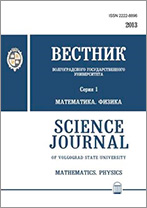|
Mathematics
The approximation approach to construction of
solutions of boundary value problems on non-compact Riemannian manifolds
E. A. Mazepa
Volgograd State University
Abstract:
This paper is devoted to the development of approximation approach
to the construction of solutions of boundary value problems
for semilinear elliptic equations on arbitrary non-compact
Riemannian manifolds. Methods of studies are essentially based on
approach based on the introduction of equivalence classes of
functions on Riemannian manifold [5; 6; 9]. Also it summarizes the
methodology for constructing a generalized solution of the
Dirichlet problem for linear elliptic equations in bounded domains
of $ R ^ n $ and arbitrary noncompact Riemannian manifolds (see:
[2; 3, p. 237–240]).
To date, there are several approaches to the introduction of the
generalized solution of boundary value problems. One
of them is based on Hilbert space methods and allows you to define
the action elliptic operator on a much wider class functions,
rather than class $ C ^ 2 $.
Another approach to the construction of generalized
solutions of elliptic equations originates in papers of
Poincare late 19th century. He created a method allowing to
consider solutions Dirichlet problem without any restrictions on
the domains in which it can be solved, but remaining in the
classical assumptions with respect to continuity of boundary data.
Ideas of this method were embodied in papers of Perron, Vallee
Poussin, M.V. Keldysh, A.A. Grigoryan.
In this paper we study bounded solutions of the semilinear equation (2)
$$
\Delta u = \phi (| u |) u,
$$
where $ \phi (\xi) $ — nonnegative nondecreasing continuously
differentiable function in the $ \xi \geq 0 $.
We introduce the following notation. Let $M$ be an arbitrary
smooth connected noncompact Riemannian manifold without boundary
and let $\{B_k\}_{k=1}^{\infty}$ be an exhaustion of $M$,
i.e., a sequence of precompact open subsets of $M$ such that
$\overline{B_k}\subset B_{k+1}$ and $M=\bigcup_{k=1}^{\infty}B_k$.
Throughout the sequel, we assume that boundaries $\partial B_k$
are $C^1$-smooth submanifolds.
Let $f_1$ and $f_2$ be arbitrary continuous functions on $M$. Say
that $f_1$ and $f_2$ are equivalent on $M$ and write
$f_1\sim f_2$ if for some exhaustion $\{B_k\}_{k=1}^{\infty}$ of
$M$ we have
$$
\lim_{k\to\infty}\sup_{M\setminus B_k}|f_1-f_2|=0.
$$
It is easy to verify that the relation "$\sim$" is an equivalence
which does not depend on the choice of the exhaustion of the
manifold and so partitions the set of all continuous functions on
$M$ into equivalence classes. Denote the equivalence class of a
function $f$ by $[f]$.
A function $f$ is called asymptotically nonnegative whenever there
exists a continuous function $w\geq 0$ on $M$ with $w\sim
f$.
Say that a boundary value problem for (2) is
solvable on $M$ with boundary conditions of class $[f]$ whenever
there exists a solution $u(x)$ to (2) on $M$ with
$u\in [f]$.
We introduce the concept of a generalized solution of the boundary
value problem with the boundary the conditions of the class $ [f]
$ for the equation (2) on manifold $ M $. To do
this, we consider the sequence of decisions boundary value
problems (3) in $ B_k $
$$
\left
\{
\begin{array}{lcl}
\Delta u_{k, f} = u_{k, f} \phi (| u_{k, f} |) \quad {\text in} \quad B_k {,} \\
u_{k, f} |_{\partial B_k} = f |_{\partial B_k}. \\
\end{array}
\right.
$$
It is shown that the above sequence $u_{k, f}$ of decisions has a
convergent subsequence with limit function $u_f$, which is a
solution of equation (2).
In the case when there are no solutions of equation
(2) with the boundary conditions of the class
$ [f] $ on the manifold $ M $, the function $ u_f $, described
above, call a generalized solution of equation
(2) with the boundary conditions of the class $
[f] $.
Remark.
This approximate approach to the definition of a generalized
solution of the boundary value problem (in particular, the
Dirichlet problem) for harmonic functions in bounded domains of
$\mathbb{R}^n $ goes back to the works of Wiener and Keldysh (see
[3, p. 237–296]), and similar studies for linear
elliptic equations on manifolds were held earlier in
[2].
Proof of the main results is based on the principle of maximum,
theorem of uniqueness for solutions of linear elliptic
differential equations and similar results for solutions of quasilinear elliptic
differential equations on precompact subset of $ M $ (see [5; 6]).
The following theorem is the main result.
Theorem 1. Let $ f $ — asymptotically non-negative continuous bounded on $ M $ function, then
1) the sequence of functions $ u_{1, f}, \ldots, u_{k, f}, \ldots $ is a solution of (3) converges uniformly on $ M $ to the limit function $ u_f $;
2) the function $ u_f $ does not depend on the exhaustion $ \{B_k \}_{k = 1}^\infty $ manifold $ M $ and $ f $ representative of the equivalence class;
3) if a class $ [f] $ is valid for the equation (2), then the function $ u_f $ is the only solution of
the equation (2) on $M$ such that $ u_f \in [f] $,
those $ u_f \equiv u $.
Keywords:
semilinear elliptic equation,
boundary value problem, approximation approach, generalized
solutions, noncompact Riemannian manifolds, the Dirichlet problem.
Citation:
E. A. Mazepa, “The approximation approach to construction of
solutions of boundary value problems on non-compact Riemannian manifolds”, Vestnik Volgogradskogo gosudarstvennogo universiteta. Seriya 1. Mathematica. Physica, 2015, no. 5(30), 25–35
Linking options:
https://www.mathnet.ru/eng/vvgum77 https://www.mathnet.ru/eng/vvgum/y2015/i5/p25
|

|




 Contact us:
Contact us: Terms of Use
Terms of Use
 Registration to the website
Registration to the website Logotypes
Logotypes








 Citation in format
Citation in format 